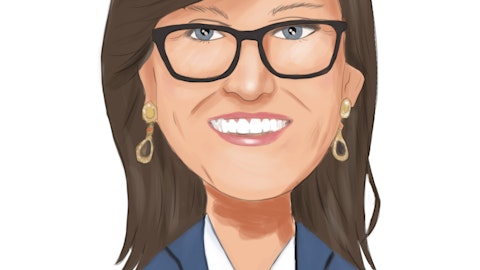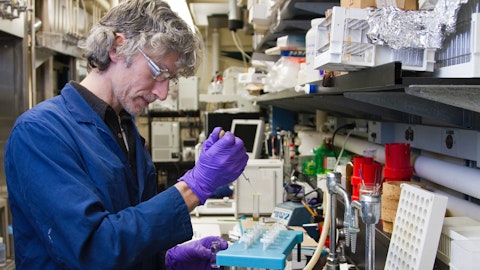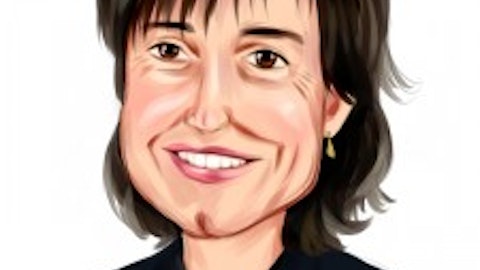Tejas Savant: Hey, guys. Good evening. Maybe I’ll start with one on the guide. Serge, just given your comments earlier this afternoon on how you think about the three different platforms and the distinct value propositions, you kind of laid out the case for Xenium versus Visium. But what do you think about sort of Xenium versus potentially Chromium? And then secondly, in terms of just the Visium HD launch, are you thinking of that as essentially replacing the Visium sales in the model over time if and when Visium HD goes live?
Serge Saxonov: Yes. So, to the first question, Xenium versus Chromium, so a couple of things. I mean, I think embedded in your question maybe is the question of cannibalization and potential reinforcement. So, when you look at how in situ is used in general traditionally and when we look at the previous instantiation like CARTANA experiments, all of them are used, pretty much always used Chromium data, single cell data as complementary. And we see that continuing. So, to a large extent, we see Xenium as being complementary to Chromium. We also — to the question of cannibalization, there’s potential for some of them — if not potential is probably stronger with like really early technology adopters, people who are particular oriented toward new technologies.
And certainly, they’re going to be kind of single cell or something, Chromium or something that was super new few years ago, now Xenium is going to be that new thing. And so, there could be potential shift in some attention But keep in mind that the Chromium market now is much, much larger than that. And there’s lots of enthusiasm, lots of momentum behind projects that really require that single cell to Chromium approach. And so, we do see that the — again, the tool will exist. While there’s going to be some amount of potential cross cannibalization, they do exist in very complementary swim lanes as well. Your question around Visium HD and Standard Visium, we’ll see, we’ll talk more about it when we get closer to launch. And we certainly have, like I said, a long very high enthusiasm, and we’re seeing that from customers around Visium HD, huge potential, lots of excitement.
Tejas Savant: Got it. And then, as a follow-up on the Xenium here again, any — I know you want to — you probably don’t want to get into the specifics of the order book, but any color you can share in just month-over-month trends through January? Second, where do you expect to be in terms of the instrument manufacturing scale up, Justin, to your point on a relatively complicated instrument exiting the year? And any color you can share on the list price versus discounting versus some of the bundling that you’ve spoken about in the past across your portfolio in terms of the ’23 outlook?
Justin McAnear: Hey, Tejas, this is Justin. I’ll start with the month-to-month trend. So, as you know, we don’t disclose pre-orders or orders those aren’t sales. We’re focusing entirely right now on ramping up the operational supply chain manufacturing and continuing to build out the installed teams. Demand is strong. We don’t see demand as being an issue in the near term. As far as manufacturing overall, we — this is the most complex product that we’ve ever built and it was produced on a compressed timeline that we pulled forward. So, we’re continuing to focus operationally. We see that as a strength longer term. We’re working to move as fast as we can. But there could be constraints on that side as we move forward in the future, and we get past these initial placements that we’re thinking more deliberate about and going towards just more widespread placements. And then, what was the third part of your question? I think we covered all three. Okay.
Operator: Thank you. Our next question comes from the line of Patrick Donnelly with Citigroup. Please go ahead.
Patrick Donnelly: Hey, guys. Thanks for taking the questions. Justin, maybe to stick with the guidance. Just want to get a flavor of kind of how you approached it relative to last year. In 2022, you had a few things pop up. Obviously, the lockdowns in China being the most significant, but then cold chain issues in Europe. You talked a little bit about this year, you almost have more variables, right, with Xenium being kind of the bigger one. So, I guess, how did you approach it in terms of level of conservatism just given again some things can always come up and particularly around Xenium, I guess, just trying to get a flavor for the conservatism in the guide relative to how you approach things last year or the year before?
Justin McAnear: So, overall, our philosophy on guidance hasn’t changed. It’s a balanced view that we’re looking at overall with upsides and downsides across all products and all the factors that we’re aware of that go into it. I would say that this year though one thing that’s a little bit different in formulating that view is the growth rates that we’re projecting for later in the year. We’re not getting too far ahead of ourselves as far as projecting growth rates that we aren’t seeing right now. And so that was the base assumption that was going into planning the rest of the year. And then, as far as just looking at the guidance overall, like I mentioned, a big portion, I think, of the variability that we could see in the year is going to be how Xenium instruments ramp.
And so, we didn’t want to get too far ahead of ourselves there either. And so, if there was one part of the guide, it would probably be — a little bit more on the conservative side, it would be just what we’re assuming for the Xenium ramp. And as the year progresses, we’ll update that as we go forward.
Patrick Donnelly: Understood. Okay. That’s helpful. And then, Serge, maybe on Visium HD, can you just talk through, I guess, what steps are left to get this out to the market? I know we were chatting a little bit last week at AGBT about — it sounded like there were maybe more technical challenges than you expected initially, you got through a lot of that. So maybe just your view the road map to commercialization here? What steps have already been taken and kind of where — what inning you think we’re in, if that’s the right way to ask? Thank you, guys.
Serge Saxonov: Yes. We talked about last time. As I mentioned at AGBT, we showed some really, really exciting data that we’re now producing internally. We’re working really hard. The team is working really hard to get the product to market, a lot of enthusiasm from customers. We’re not at the stage ready to give an update on the time line or on the state of development. But I do want to emphasize that we’re very strong, we’re committed to the platform, and I’m very excited by what it will enable with our customers.
Operator: Thank you. Our next question comes from the line of Julia Qin with J.P. Morgan. Please go ahead.
Julia Qin: Hi, good afternoon. I wanted to touch on Chromium trends since biopharma is at the core of grabbing up data, volume scale and translational use, could you give us an update on your progress in penetrating biopharma accounts? And for the new Chromium instruments that you’re placing or the consumable utilization, how much of that is driven by biopharma accounts? And what is a reasonable kind of medium-term target that you’re thinking about?
Serge Saxonov: Yes. In terms of biopharma adoption, I would say as it’s kind of — as we’ve talked about it before, we have — we see that we have a strong beachhead and our biopharma sort of progress — has got like sales into biopharma has been tracking pretty similar to our sales in academia, and they still are. It’s — we do expect that over time, the other future potential within biopharma applications, and we do expect that to see realized — materialize in the coming years. Up to now, there’s been pretty fundamental barriers to adoption within biopharma due to the limitations of our products, most importantly, in ability to fix tissues and needing to work with live samples, live cells. That got addressed last year. And increasingly, as we kind of march through the year towards the end of ’22.
We’ve demonstrated more and more how the new products, especially the Flex on the Chromium side is able to work with fixed tissue in particular with FFPE samples. So, I think we now have a good baseline of product capabilities on which to build the commercial strategies to drive much more intentionally much more aggressively into biopharma. But I think that’s going to be a story going forward. That sort of potential for acceleration and not yet what we have seen.
Julia Qin: Got it. And then, a question on sort of the interplay between the single-cell and spatial side of your platform. We’ve been hearing some talks about customer budget reallocation potentially away from single-cell to spatial to take advantage of the new capabilities. So, just curious what are you seeing based on your customer conversations in terms of the budget? And then in light of that, do you see any fundamental shift in the Chromium customer mix going forward, especially once Xenium is out. Yes, any color you can share on that would be great. Thanks.
Serge Saxonov: Yes. It’s a good question and one we solely track. I think the important thing to appreciate here is that there’s different types of customers. And certainly, the early adopters, the technology enthusiasts, the people who will tend to be the earliest adopters of both the Xenium and the Chromium platform with natural shift to the latest kind of technology with expanded latest kind of technology. So, when you talk to those kinds of customers, you would expect and we are hearing that some shifting budgets towards Xenium potentially from Chromium. But at the same time, the Chromium customer base is much larger certainly these days than the initial technology early adopter people. There’s lots and lots of mainstream biologists who are using Chromium.
There’s lots and lots of now translational customers that are using Chromium and there, things are just getting started. And there are thousand tons of applications that people are looking to do specifically in Chromium where Chromium is a much, much better fit for many reasons. And of course, there is applications where it’s always going to be really associated single-cell. It’s always going to be the right approach, whether if you’re starting with associated samples like blood, where you’re working on various combinatorial screens, crisper screens where the cell is the fundamental unit of experiment where it’s always going to be really based around the Chromium approach. So, while it is — we are seeing some amount of budget shifts to Xenium, we think a large majority of the Chromium franchise is going to keep expanding, keep growing.
Operator: Thank you. Our next question comes from the line of Kyle Mikson with Canaccord Genuity. Please go ahead.
Kyle Mikson: Hey, guys. Thanks for the questions. Multipart question on Xenium to start. It’s really your first instrument, maybe not, maybe other than the Connect, it possibly that kind of has this price point that might start to trigger evaluation from like the higher-level individual or institutions. How are you thinking about your sales team ability to adjust to that new sales cycle here and like close deals? And do you think there’s going to be a growing pain, especially in light of those changes in ’22 and Jim now leading? And there’s always this like initial training period for years of a new platform. And when we speak to the early users, it sounds like they’re just entering that true sample processing phase with Xenium. So, within the guidance, how long do you say it’s going to take for the early adopters, like that was like 1Q and 2Q, placements to kind of ramp up their usage of the platform?
Serge Saxonov: So, maybe kind of to start with on just the general commercial evolution that we’ve talked about before. We have a great foundation of — in our commercial organization and a huge reach, really lots of talent in organization and we plan to leverage that commercial foundation for growth into this year and beyond. We’re adding new tools. We’re adding new proxies, common language, reengineering some of our sales incentives. And I think there’s a lot of good stuff that’s happening. And we see that, that’s going to help us throughout — certainly now and throughout this year and going forward. In terms of — what’s the second question?
Kyle Mikson: Yes, just like the initial training period is pretty long, so do you think it’s going to take a long time to ramp their usage of the platform? Like what expect — what’s included in the guidance maybe?
Serge Saxonov: Yes, in terms of the Xenium ramp-up, that’s something that we’re going to have to see. Like we said, the initial signs are pretty encouraging. People pretty quickly get up to speed, and we’ve seen some very early results from customers running their own samples on our instruments. So that’s very encouraging. But very, very early right now. So — and of course, we incorporate all that knowledge in our expectations.
Operator: Thank you. Our next question comes from the line of Matt Larew with William Blair. Please go ahead.
Matt Larew: Hey, good afternoon. Just wanted to ask a bit about the cadence of the year. I think some periods, typically had about 55% of sales in the back half and the way a bit higher instruments. Just given your comments on China, and the Xenium instrument ramp, maybe just help us think about whether there might be a greater skew to the back half of the year this year?
Justin McAnear: As far as seasonality goes, we’re not expecting anything out of the ordinary. We do expect the seasonality to be similar to the average of the last couple of years.
Matt Larew: Okay. And then, Serge, following up on your comments. Obviously, the commercial team went through leadership and meaningful infrastructure changes last year, bringing on new tools, new (ph). Maybe just how do you feel about where the organization is at from a personnel perspective? And is this more of a year of additional investments or more of a harvesting some of the investments that have been made?
Serge Saxonov: I think like in all of this, like building the company, building organizations, it’s always a long-term journey. We feel good about where we are. We’re putting a lot of new pieces in place. And it’s going to — we’re going to keep doing that. So, I don’t see it as necessarily harvesting. We certainly will take advantage of what we have done, and we’ll keep doing more.
Operator: Thank you. Our next question comes from the line of Michael Ryskin with Bank of America. Please go ahead.
Michael Ryskin: Great. Thanks for taking the question, guys. First, I want to talk about some of the new metrics going forward. For example, you talked about a 2% increase in reactions year-over-year for 2022. Just so we get some familiarity with that metric going forward, any sense of what a good bogey that will be in 2023, just so we can try to think about reactions versus revenue growth? And any thoughts on how that pace throughout the year last year, sort of did it come in ahead of expectations, below expectations? Just a little bit more context there.
Justin McAnear: Yes. As far as the guidance for 2023, we’re guiding on revenue dollars and gave some of the expected growth rates across the different platforms. As far as reactions, one thing to keep in mind when you’re looking at the change in reactions is our reaction is the physical product that we sell, but there’s also samples that go into reactions. And it’s — and as you know, as customers multiplex more, they can get more samples per reaction. And that’s difficult for us to track. We can get a sense of that somewhat anecdotally. And we know that, that’s been increasing, especially over the last year. And our newer products, products we released in the past CellPlex have enabled that, and then some of our newer products, it’s built in fundamental to the product as well.
And so, I do think that, that can be a decent variable that can impact the number of reactions from year-to-year. As far as the price points on it, the cost per reaction has been trending up over the last couple of years. When you’re looking at a Visium reaction compared to a single-cell reaction, all-in cost for that Visium is a little bit more. But really, on average, within that $1,300, $1,400 range across all products.
Michael Ryskin: Okay. All right. I appreciate that. And then just for the follow-up, I wanted to just tie up some loose ends that you mentioned earlier. I mean, you talked about, for example, Justin, talked about low to mid-teens on Chromium and 40% year-over-year spatial. But I don’t think we have an accurate base for 2022. I mean, we have some numbers from your Analyst Days, but not for the full year. So, could you just give us a sense of what the full year number were? And then also on China, you commented on 1Q, but what about the full year for China? Any thoughts there or maybe some thoughts on your assumptions? When do you think China will normalize as the year goes ahead? Thanks.
Justin McAnear: Sure. So, let’s start on the 2023 guidance overall on Chromium. Within our guidance range, we’re talking low to mid-teens year-over-year increase for Chromium. In spatial, it’s at least 40%. So, 40% on the lowest end and then ramping up inverse to how the Chromium increase would be ramping up. So not 40%, but more than 40% for spatial. As far as looking at Q4, we did give you information on Q3 at the Analyst Day, but looking at Q4, spatial was about the same percent of revenue in Q4 than it was in Q3. So, the same percentage of the — roughly the same percentage and a higher revenue base. And then as far as how things — we expect things to progress for the rest of the year, especially with China. As I mentioned earlier that we are seeing impacts to China right now.
We do think that China is going to be roughly somewhere in the ballpark of 20% down year-over-year. What we are seeing and hearing right now from our team in China is that activity levels are looking good and activity levels are recovering. We’re also hearing that inventory levels at the service providers and the distributors are higher, as they were coming off of this level of disruption before the activity came back up, there’s now some inventory to work through. So, we see that having an impact to Q1. We’re expecting an impact in Q1. Aso expecting somewhat of an impact in Q2, although not as great as Q1, and then a moderate improvement throughout the rest of the year. And so, if we see it get better than a moderate improvement, we’ll update that at that time.
Operator: Thank you. Our next question comes from the line of Matthew Sykes with Goldman Sachs. Please go ahead.
Matthew Sykes: Hi. Good afternoon. Thanks for taking my questions. Justin, maybe just on the first one, just on gross margin. I know you mentioned you expect to be below the level of last year, and a lot of that has to do with the new product introductions. How should we think about it over the cadence of the year? I mean, should we think about a sort of a lower level consistently throughout the year? Or is there going to be some level of change in cadence of gross margin as we move through the year?
Justin McAnear: Hey, Matt. When you’re thinking about gross margin for this year, the biggest driver on gross margin is going to be what percent of overall revenue is Xenium instruments. So, the Xenium instrument itself, it’s a low-margin instrument for reasons that I’ve gone over before. The consumables though, are more comparable to the consumables that we currently sell. And so, there is going to be an impact throughout this year. I think it’s going to continue to trend lower throughout the year as we increase our Xenium placements and also the percent of the overall revenue increases. I do think that there will be partial offsets as the consumables revenue stream on those continues to ramp up as well. But as far as how the consumables ramp compares to the instrument ramp, it’s too early to make a call on that.
So, I think the best assumption is just that it’s going to continue to trend lower throughout the year, and it’s going to flex according to the number of overall placements.
Matthew Sykes: Got it. That’s helpful. And then, Serge, just on the commercial strategy, you had mentioned in your prepared comments about changes you made. I know you hired Jim last year. But any more detail that you can provide just given that you’re now a multiproduct company, looking to scale as well as grow. Could you maybe talk about some of the changes that you made or some of the things you might be doing differently this year as you’re dealing with multiple products in the marketplace?
Serge Saxonov: Yes. So definitely, the complexity of our platforms and products that has increased and — substantially, especially with the introduction of Xenium, which is the most kind of the biggest instrument, the most complex instrument we’ve got before. That said, as we’ve also talked about before, the products are highly complementary. And there’s a huge overlap in customers and a huge overlap in terms of being able to use them in complementary ways. So that’s something we’re definitely leaning into and certainly taking advantage of our entire sales force and commercial force to help the different platforms support each other and reinforce the mutual advantages. We’re also recognizing that some of them require a bit more focus, we are investing in some amount of specialization on — certainly on the sales side and the marketing side and support side to — especially to help with the Xenium.
Operator: Thank you. Our next question comes from the line of Justin Bowers with Deutsche Bank. Please go ahead.



